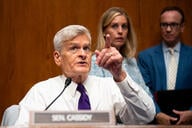You have /5 articles left.
Sign up for a free account or log in.
Last year -- my first as the president of a liberal arts college -- I attended a gathering of about 40 college and university presidents along with various experts on higher education where the challenges of higher education were being discussed. At one point during the meeting, all other attendees were asked to exit the room, leaving just the college leaders. The idea was to give us the opportunity to have an honest and forthright discussion, to offer questions and answers about issues such as increasing diversity and improving accessibility that we had all agreed were crucial.
I asked: since we effectively had the power in that room to transform the world of higher education, why weren’t we doing it? Much to my consternation, one of my peers responded that we are “lacking in both the individual and collective courage to do so.” This is indeed troubling.
I’ve been struck by the challenges facing higher education today. And, as someone who has spent his career in higher education, first as an academic and then as an administrator, I believe the issues facing higher ed leaders now are more profound than at any other time in the last several decades -- and are perhaps even unprecedented.
We face mounting pressure from all sides to do well in the rankings and increase revenue; but, as our institutions become significantly more market driven, we’re in grave danger of losing touch with our core academic missions. Reports like the one issued by the Spellings Commission are escalating the demands on leaders for new approaches to the pressing issues facing higher education including affordability, access, and outcomes assessment. There are also genuine real-world problems -- challenges that impinge directly on our institutions and missions -- from trying to keep pace with the breathtakingly rapid changes in technology to facing a global environment rife with injustice, violence, and a deepening divide between world cultures and religions.
And what do people hear about us, the leaders of these institutions? Often, media coverage characterizes college and university presidents as highly compensated career opportunists more concerned with our generous perks and benefits than in tackling the tough issues facing our institutions today.
It is therefore disconcerting to me that the traditional model of college leadership does not appear to be up to the challenge. The new and evolving demands being placed on our leadership need new and creative strategies. And we educational leaders must look to each other for examples of successful experimentation and innovation as well as for counsel and criticism.
There is cause for optimism. If we look beyond the overheated rhetoric, we see individual examples of educational leaders rising to meet these challenges. Deborah Bial, founder of the Posse Foundation, for example, is helping bring about greater social and intellectual pluralism on American campuses. Lloyd Thacker is working to restore reason and educational values to calm the admissions frenzy through the Education Conservancy. And with his colleagues, William Bowen has done groundbreaking work in setting a national agenda for substantive assessment and reform in the areas of race sensitive admissions, college athletics, and most recently, socioeconomic status and educational attainment.
At Lafayette College, we are in the throes of developing a strategic plan and using a very inclusive, time-consuming, and at times down-right frustrating process. The challenge has been to make this process open and interactive enough to gain the benefit of valuable individual contributions while creating a vision that is widely embraced and actively supported.
As we move forward, it seems increasingly clear to me that presidential leadership must acknowledge that fundamental tensions exist between what we feel pressured to do to be successful leaders today (such as raising funds and worrying about rankings) and what, ethically, we need to do (improving the quality of the academic core of the institution, increasing diversity and accessibility, and producing an engaged and enlightened citizenry.) As educational leaders, the most important challenge facing us today is balancing these fundamental tensions.
As we continue the work on our strategic plan here at Lafayette, we have been thinking about how to balance some of these conflicting pressures:
1) The commitment to educational excellence with the prudent management of costs. But that’s just the tip of the iceberg. To reach this seemingly straightforward objective, two fundamental facts have to be addressed.
First, especially at liberal arts colleges, our model of education -- that of faculty working closely with individual students -- is inherently inefficient and always will be. There is no substitute for individual mentoring, teaching in small classes, or interaction between students and faculty outside of the classroom. But there are opportunities to do this work more effectively, beginning with more efficient use of technology and better use of faculty time. (As a start, we might reduce by half the number of committees on which our faculty members are required to serve which would free up several additional hours per month for each of our professors to work with students).
Second, it requires college leadership to understand that a hand-tooled education is, above all else, what makes a student’s college experience distinctive -- and it is worth the cost. If we acknowledge these factors, we set priorities more clearly and manage more effectively.
2) The enduring values of a liberal education with support for the skills needed in an increasingly professional marketplace. Students and their families have begun to question the utility of a broad, values-based curriculum in this fast-paced, skills-driven economy. They are concerned, and justifiably so, about outcomes and their prospects for gainful employment. However, we need to make clear that, for most of our students, the real value of time at college is to obtain a liberal education: to encourage individual growth, the cultivation of ethics, new capacities for expression, and most important, the skills and desire to continue learning.
3) Preparing students to function in a global environment, regardless of where they are located or the limitations of resources. By providing them with an educational experience that is international in reach and presence, they will have a basis for understanding what it really means to be global citizens. I see this not so much as a technological or logistical challenge as a creative one requiring new thinking about curriculum, allocation of faculty resources, and campus climate. For example, at no additional cost, a small number of existing faculty positions might be redeployed to support a program for visiting international faculty in various content areas.
4) Strengthening our core programs by reaffirming our commitment to community and civic engagement. Our institutions need to show by example the type of community partners we can and should be. At Lafayette, service learning has been used to great educational and community benefit in many of our departments, including civil engineering, English, economics, sociology and mathematics. By modeling values and principles we espouse and encouraging students to join us in this work, we can help instill greater recognition of the importance of civic engagement and an educated citizenry. We serve our educational mission best when we foster our role as vital and engaged citizens, connected in myriad ways to our communities and to the world.
5) Embracing technology as a fundamental component of the educational process not merely its infrastructure. This too, at bottom, is not a resource problem -- it’s a question of vision. We must understand that technology is no longer a productivity enhancer nor a marginal benefit. Rather it is a core element of our educational system just as it is for our society. It’s difficult to be a technological leader if we can’t keep pace with the technological sophistication of our own students. This was brought home to me recently when a student complained about a faculty member who was still using old-fashioned e-mail rather than a hand-held PDA. Academic and facilities planning must include various perspectives on how technology contributes to learning across the disciplines and the campus.
6) Pursuing excellence and an agenda of pluralism. True diversity -- social and intellectual pluralism -- enriches the educational possibilities by a measure greater than any other means. Diversity in its broadest sense must be a core value of higher ed institutions because it provides us with the optimal access to talent, quality of learning environment, and service to our social mission. To achieve this, however, it requires rethinking the admission and financial aid paradigm, the structure of the curriculum, and the very nature of the communities we create. Difficult though it is, initial success in student recruitment is far easier than the ongoing challenge of maintaining a vibrant community that is fundamentally diverse.
The challenges are great but the opportunities to do the right things on the right issues are greater. If we wish to succeed in the new century -- if we wish to have a transformative impact on higher education in America and throughout the world -- we must accept the challenge that we can do more for our students and the broader communities that we serve. The work ahead will require both individual and collective courage.




